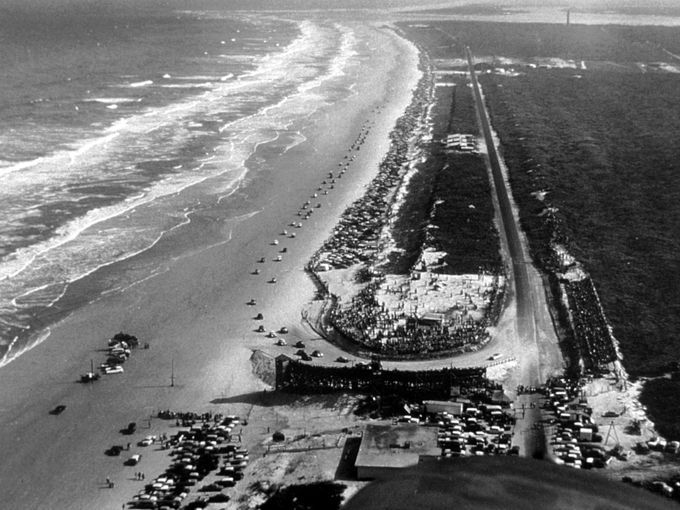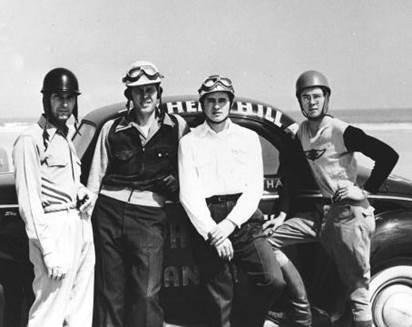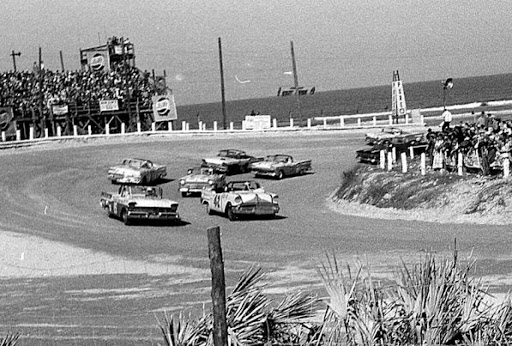Daytona Beach – Welcomed Road Course Racing in the 1930s
NASCAR’s top three national series are ready to make their second attempt on the iconic DAYTONA Road Course inside the Daytona International Speedway this weekend, Feb. 19-21, for an exciting tripleheader. It features Friday’s BrakeBest Select 159 At DAYTONA presented by O’Reilly Auto Parts (NASCAR Camping World Truck Series), Saturday’s SuperStart 188 At DAYTONA presented by O’Reilly Auto Parts (NASCAR Xfinity Series) and Sunday’s O’Reilly Auto Parts 253 (NASCAR Cup Series). dway.com or call 1-800-PITSHOP).
With all of the anticipation, let’s take a look back at how road course racing began in Daytona Beach, “The Birthplace of Speed.”
The history of automotive competition in the Daytona Beach area goes back to 1903. It is recorded that it started with a friendly wager between two men debating who had the fastest horseless carriage. The wide, hard-packed sands of “The World’s Most Famous Beach” were the scene of more than 30 years of speed trials.
Then in 1935, the final speed trials were held, and moved to the Salt Flats in Utah. To continue the legacy of speed, stock car racing began on the beach in 1936. The concept was racing modified stock cars on a circuit that utilized both the Atlantic shoreline and the pavement of State Road A1A, the legendary oceanfront road. The original 3.2-mile course had the north turn located near the center of town. It ran approximately 1.5 miles north on the beach and then 1.5 miles south on a paved, public roadway with two portions connected by banked, sand turns.
Entered in the event was a larger-than-life man named “Big” Bill France. He witnessed the final year of speed runs on the beach and was fired up about what Daytona meant to auto racing on a global scale. His enthusiasm was largely born out of being a competitor, even though the idea of promoting races was lurking in the back of his mind. He finished a solid fifth in the 250-mile event, and knew that he could win stock car races on a regular basis, but also if pressed into service, he could be a successful promoter.

The first couple of years the road course was losing money, and the local chamber of commerce approached Big Bill, asking if he could help find a promoter for the road course. The idea of promoting a race excited him, and he told city officials he was the perfect man for the job. While driving a race car at various tracks across the Southeast, owned by Daytona Beach restaurant owner Charlie Reese, Big Bill asked Reece if he would give support financially to help him promote the beach course. A partnership was formed, and Big Bill began to wear two hats.

In 1939, Bill Sr. accelerated his driving and promoting ambitions, and the Daytona beach-road course was becoming successful. Behind the wheel in races on the beach-road course, he finished fourth and second, and a year later, he had a break-through victory, along with other track wins to win an “unofficial championship” crown. He would promote races on the beach and at various tracks in North Carolina before the attack on Pearl Harbor in December 1941, which halted racing. Post war in late 1945, the Daytona beach-road course needed a tune-up and renovations after several years of inactivity, and in the spring of 1946, stock car racing was reborn.
The realities of a growing Daytona Beach populace on the beachside forced Big Bill to abandon the original 3.2-mile layout at the end of 1947. He was running out of room to both race and provide space for spectators. A new 4.1-mile course near Ponce Inlet was created in 1948 where the stock cars would compete.
On Feb. 21, 1948, NASCAR would become officially incorporated. Big Bill would be in charge of the new sanctioning body, promoting not only races at the beach-road course but a full championship schedule as well. NASCAR was founded on the simple idea that many people loved revved-up engines and fast cars as much as Big Bill did.
The modified stock cars that had been competing was not the only direction Big Bill wanted to go in moving forward. In 1949, he demonstrated his determination for a vision he had years earlier, but had been delayed by the war. From 1942-46, a small amount of consumer cars had been built, reducing the availability of the machines from showroom floors by the car manufacturers. It was now time for his “Strictly Stock” concept (what would become known as the Grand National Series, and years later, the NASCAR Cup Series), a series for new sedan cars, that would produce a national championship series.
The first Strictly Stock race was held in Charlotte on June 19 on a ¾-mile dirt track. Then, less than a month later, on July 10, 1949, the first Daytona beach-road course for the Strictly Stock division was held. It was the beginning of bigtime beach-road course racing in Daytona Beach and the phrase “win on Sunday, sell on Monday” for the car manufacturers. For nearly the next decade, the beach-road course would play a pivotal role in the early stages of NASCAR.
During this time period, Big Bill saw that the days of racing on the beach-road course were numbered due to the spreading land usage of a rapidly growing population and huge race crowds. He put a plan for the future of Daytona Beach in motion with a proposal to construct a permanent speedway facility that would become Daytona International Speedway, which hosted the first DAYTONA 500 in 1959.
As a result, the Daytona beach-road course race in 1958 was the grand finale for the asphalt and sand. The 10-year stretch of memorable moments will never be forgotten.
Below are quick recaps of each of the historical races, today known as the NASCAR Cup Series, on that iconic 4.1-mile Daytona beach-road course, located near Ponce Inlet.
July 10, 1949
Red Byron of Atlanta took the lead from Gober Sosebee with six laps remaining and went on to win the 166-mile NASCAR Strictly Stock (changed name to Grand National in 1950) race. Sosebee, who had taken the lead from Joe Littlejohn just after the drop of the green flag, appeared headed for the $2,000 victory but his Oldsmobile bobbled as he negotiated the North Turn on the 34th lap of the 49-lap contest. Byron would go on and win the championship.
February 5, 1950
Harold Kite, a former Army tank driver who began racing on the short tracks after World War II, drove past Red Byron on the 25th lap (of 48) to score a convincing triumph in the season opener over Byron. Competing in his first NASCAR “Grand National” event, the East Point, GA, driver pushed his Lincoln around the sandy course at a record speed of 89.894 mph to win by 53 seconds.
February 11, 1951
Marshall Teague, the 29-year-old hometown favorite, wheeled his Fabulous Hudson Hornet around Tim Flock’s Lincoln with 12 laps remaining to win the 160-mile Grand National race. His margin of victory was 74 seconds. Flock’s pit crew had an issue fueling his machine during a routine pit stop after leading the first 27 laps, but was able to recover to finish second. His brother, Fonty Flock, was third, followed by Bill Blair and Buck Baker.
February 10, 1952
For the second straight year, Marshall Teague, in his Fabulous Hudson Hornet, kicked off the season with a victory, outrunning his teammate, Herb Thomas, to win the 151.7-mile race at an average speed of 85.162 mph. The race started late to allow an unexpected crowd of 20,000 spectators to find parking spots. With a delayed start, the 200-mile race (48 laps) was cut short to 37 laps due to an incoming tide.
February 15, 1953
After three finishes in the top six in the first four Daytona beach-road course races, Bill Blair finally reached the pinnacle of victory, beating Fonty Flock by 26 seconds.
Blair, in an Oldsmobile, led on the last lap, taking advantage of Flock, who ran out of gas as he took the white flag. His teammate Slick Smith helped push his car to the pits for fuel. Because NASCAR rules permitted a car to be assisted to the pit area, but not to be pushed from the pits, Flock rebounded to finish second.
February 21, 1954
Lee Petty was declared the winner after apparent winner, Tim Flock, was disqualified because of an altered carburetor. The decision wasn’t popular with Flock, who quit driving NASCAR for the rest of the year. Petty, who would go on and win the first-ever DAYTONA 500 on the 2.5-mile high-banked facility in 1959, beat Buck Baker by nine seconds.
February 27, 1955
Tim Flock, after being disqualified the previous year, rebounded to win after Fireball Roberts was disqualified for push rods in his engine being altered.
Flock was teaming with car owner Carl Kiekhaefer for the first time, and the No. 300 Chrysler finished ahead of second-place Lee Petty, who was the beneficiary of Flock’s misfortune a year before. It was Flock’s first NASCAR race since the Daytona beach-road course event in 1954.
February 26, 1956
For the second time in the event’s history, the Daytona beach-road course race was called short of its scheduled finish – two laps shy – because of a high tide. For the second consecutive year, Tim Flock took the victory. He led all but three laps in the 37-lap, 151.7-mile event and held off Billy Myers with Ralph Moody third.
February 17, 1957
Cotton Owners picked up his first Grand National Series victory, piloting a Pontiac to the win over Johnny Beauchamp. Owens and Paul Goldsmith battled for the lead, but with eight laps to go, the engine in Goldsmith’s Chevrolet blew.
February 23, 1958
A year after a blown motor with eight laps left took away a possible victory, Goldsmith outdueled Curtis Tuner to win the final race on the Daytona beach-road course. It marked the closest finish in the 10-year history of the event, winning by a mere five car lengths.
Last August, NASCAR challenged the Speedway’s 3.61-mile, 14-turn course, made famous by the Rolex 24, for the first time. Each of the winners went on to capture their respective NASCAR Championships – Chase Elliott in the NASCAR Cup, Austin Cindric in the NASCAR Xfinity and Sheldon Creed in the NASCAR Camping World Trucks. History is set to be made again beginning Friday.

The O’Reilly Auto Parts 253 is set for Sunday, Feb. 21, at 3 p.m. ET. (frontstretch gates open at 12:30 p.m.). The event will consist of 70 laps. The weekend kickoff tomorrow (Friday, Feb. 19), with the BrakeBest Select 159 At DAYTONA presented by O’Reilly Auto Parts (44 laps) for the Camping World Trucks is set for 7:30 p.m. (frontstretch gates open at 5:30 p.m. start) while Saturday’s SuperStart 188 At DAYTONA presented by O’Reilly Auto Parts (52 laps) for the Xfinity Series gets the green flag at 5 p.m. ET (frontstretch gates open at 3 p.m.).
A limited number of tickets are still available with kids starting at only $10. Kids 12 and under are FREE on Friday and Saturday in select sections. To be a part of the action, fans can visit www.daytonainternationalspeedway.com or call 1-800-PITSHOP.
All events will be conducted in accordance with enhanced safety protocols and procedures to provide a safe environment for guests, NASCAR competitors, employees and the local community. All guests will be screened before entering the facility and will be required to wear face coverings while maintaining six feet social distancing throughout their visit.